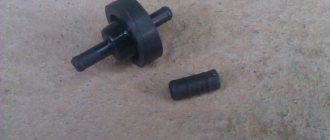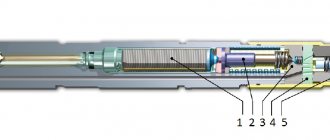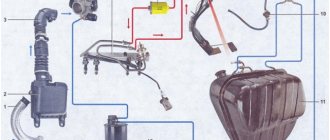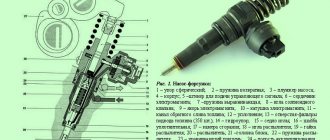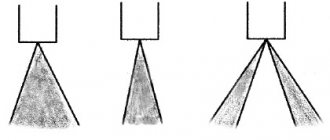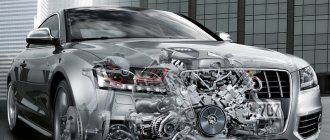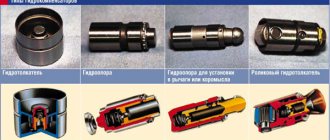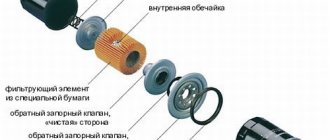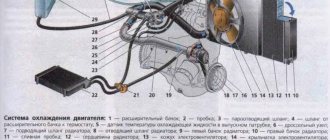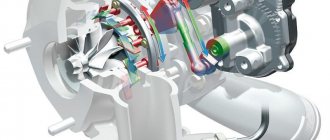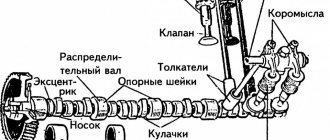Unit injectors
The injector pump for diesel engines is installed individually for each cylinder. They are mounted in the cylinder head, and it is very important to perform correct installation.
Sectional view of pump injector
The pump injector is driven from the engine camshaft. The injector pump consists of the following elements:
- Ball head screw.
- A plunger equipped with a spring creates working pressure inside the nozzle. It is driven by the camshaft cam mechanism and returns to its original position under the influence of a spring.
- Drive cam.
- Rocker.
- Seals – ensure the tightness of the nozzle.
- High pressure chamber.
- Needle – performs fuel injection.
- Valve – can be electromagnetic or piezoelectric. It is used to control the injection process. The piezoelectric valve is more modern.
- Intake line – supplies fuel to the injector.
- Drain line.
- Check valve and shut-off piston - maintain fuel pressure at a given level.
The piezoelectric valve operates much faster than the electromagnetic valve, and its operation is controlled only by changing the voltage supplied to it. Structurally, it consists of a piezo actuator located in a housing equipped with a plug connector, as well as a lever multiplier and a spray needle.
The design of the pump-injector system
The pump-injector system includes such elements as: a plunger, a shut-off piston, control and check valves, and a spray needle.
The plunger is designed to create working pressure inside the nozzle. In this case, the translational movement of the plunger is ensured by the camshaft cams, and the return movement is provided by a spring. The main function of the control valve is fuel injection, or rather injection control. In such systems, two types of valves can be used - electromagnetic and piezoelectric. A valve based on a piezoelectric element is more advanced due to its high speed. The main design element of the control valve is its needle. The nozzle spring is necessary to ensure that the nozzle needle is securely seated in the seat. The spring force is complemented by the force of the fuel pressure, and all this is done using a shut-off piston installed on one side of the spring and a check valve located on the opposite side of the spring. The nozzle needle provides direct injection of diesel fuel into the combustion chamber of the engine. The pump injectors are controlled by an engine control unit, which, based on data received from sensors, controls the operation of the pump injector valve.
How does a pump injector system work?
Effective production and distribution of fuel assemblies in the pump-injector system occurs in three stages - preliminary, main and additional fuel injection. Pre-injection
The pre-injection stage is designed to ensure smooth combustion of the fuel assembly during the main injection stage.
The main injection stage, in turn, ensures an uninterrupted supply of the fuel mixture in all operating modes of the internal combustion engine. So, at the preliminary stage of fuel supply, the pump injector operates according to the following scheme. The camshaft cam transmits mechanical force to the rocker arm, which lowers the plunger down. The fuel mixture begins to flow through the channels located in the injector body. Next, the valve closes and temporarily stops the fuel supply. This creates a high pressure of the vehicle, reaching 13 MPa. At this level of pressure, the needle, overcoming the force exerted on it by the spring, performs a preliminary injection of the combustible mixture. The completion of the fuel pre-supply stage is the opening of the inlet valve. Fuel enters the line, and at the same time its operating pressure decreases. At this stage, one or two injections of the vehicle can be performed depending on the operating mode of the diesel engine. Main injection
The beginning of the main injection stage is accompanied by the subsequent lowering of the plunger.
After closing the valve, the pressure of the vehicle continues to increase and reaches 30 MPa. At this pressure, the needle rises and the main fuel supply occurs. High pressure ensures significant compression of the fuel, as a result of which a larger amount of it enters the combustion chamber. The largest volume of the combustible mixture is supplied at the maximum possible pressure of 220 MPa, which achieves maximum engine power. The completion of the main injection stage occurs similarly to the previous stage after the opening of the inlet valve. This is accompanied by a decrease in fuel pressure and lowering of the spray needle. Additional injection
The final stage is an additional injection, which is used to clean the particulate filter from soot, soot and contaminants. Additional fuel is supplied when the plunger is lowered according to a scheme similar to the main injection. At this stage, as a rule, two injections of diesel fuel are carried out.
Operating principle of pump injector
The formation and distribution of the air-fuel mixture in the pump-injector system occurs in three stages:
- Preliminary injection - is carried out to ensure smooth combustion of the air-fuel mixture during the main stage of engine operation.
- Main injection – forms the air-fuel mixture in the optimal ratio for the current mode.
- Additional injection – designed to clean the system of soot residues in the filter (regeneration).
Pump injector and its position in the cylinder head
The process of operation of pump injectors is as follows:
A cam mechanism located on the camshaft acts on the plunger, moving it to the lower position. This ensures the flow of fuel through the fuel injector channels. When the valve closes, fuel stops flowing into the chamber and the pressure begins to rise to a level of 13 MPa. When a critical value is reached, the injector needle overcomes the spring pressure and begins to move to the upper position, which ensures fuel injection.
Unlike other systems, engines with unit injectors do not have a common injection pump (high pressure fuel pump). Each injector itself is a small injection pump.
Further, the operation of the injector depends on the type of injection. With pre-injection, fuel enters the intake manifold and the pressure drops. In some cases, this pattern may recur. During main fuel injection, the plunger continues to move downwards and the valve closes. The fuel pressure rises to 30 MPa and only upon reaching this level the needle begins to rise, performing injection and forming a fuel-air mixture.
The amount of fuel is adjusted depending on the pressure level, the maximum of which is 220 MPa. The main injection is completed by opening the valve, as a result of which the compression level drops and the nozzle needle lowers to its original position. Further downward movement of the plunger provokes additional fuel injection (usually there are two of them). In this case, the operation of the nozzle is similar to the main stage.
Application of pump injectors
The next step towards increasing energy efficiency was the abandonment of the storage main. In this way, unnecessary losses of pressure (and, accordingly, power) are avoided, the system becomes less vulnerable in the event of depressurization, and fuel injection is controlled in detail for each cylinder. The system as a whole becomes simpler, the machine operates quieter, and fuel consumption is lower.
The design of only one part becomes more complicated, which combines the functions of an injector and a high-pressure fuel pump.
Selection and purchase of pump injectors
For reliable operation of the fuel injection system, the pump injector is selected according to the article number, which can be determined by the part code, or using the vehicle VIN code . Only injectors of a certain model are installed on each engine, so the choice comes down only to the manufacturer’s brand, of which there are not many. The world's main manufacturers whose products are installed on the conveyor are Bosch, Denso, Siemens, Delphi.
Related terms
- Cylinder head
- ECU (electronic control unit)
Why are pump injectors needed?
The main function of pump injectors is to create high pressure of diesel fuel for injection into the combustion chamber, and at a certain moment and in a clear amount, which are set by the ECU.
Their design allows the fuel supply process to be divided into preliminary, main and additional injection phases, as well as to further increase the injection pressure (200-250 MPa). Which in turn leads to more efficient and economical fuel consumption.
Maintenance and repair of pump injectors
The specificity of modern injection systems is the high mechanical complexity of the units. Therefore, the pump injector does not have a service life and a clearly defined list of routine maintenance .
The use of cleaning additives in fuel and the injector cleaning procedure itself remain a controversial issue. As is the case with engine cleaning in general, various factors can affect the result - as a result, you can either completely destroy the pump injectors, or vice versa, extend their life. Basically, if the engine's performance doesn't bother you, then you don't need to do anything.
Remember that modern fuel systems, especially diesel ones, are very sensitive to fuel quality.
If any of the signs of a malfunction forced you to contact a specialized service, they can try to repair the pump injector using the following steps:
- check and correct the operating parameters of the pump injector on the stand;
- Clean only the lower injector part or all disassembled ;
- repair and replace worn components;
- adjust the pump injector on the stand after assembly.
Cleaning unit injectors in an ultrasonic bath
Adjusting pump injectors on a bench after assembly
If repairs do not help, the entire injector pump is replaced. It is hardly possible to repair the pump injector yourself. Firstly
, components and repair kits are mainly sold only to specialized services and are very difficult to find.
Secondly
, the work requires special tools and specialized equipment.
Thirdly
, it is impossible to adjust the nozzle operating parameters without a special adjustment stand.
Where is the pump injector located?
The injector pump is installed directly in the cylinder head. The part with the pump is located outside the block and is attached to the camshaft cams, which regulate the operation of the pump. The part with the nozzle is installed inside the block - during operation, the atomizer “looks out” into the combustion chamber, next to the outlet of the glow plug, which helps ignite the mixture.
Since the pump drive comes from the camshaft, the pump injectors are located under the valve cover , so they are not visible from the outside of the assembled engine.
Design and principle of operation of pump-injectors
The nozzle is a metal tube with a special cross-section designed to spray the fuel mixture. For the first time and to this day, such a device is used on diesel engines, where such important parameters as engine efficiency, low noise level and low exhaust toxicity are important.
The injector pump is installed above each cylinder and has the same structure. It usually includes: a shut-off piston, a special plunger, a spray device needle, a check and control valve and a spray device spring.
The plunger is a part that creates a certain pressure inside the nozzle. Pumping occurs during the translational movement of the plunger. To do this, there are special cams on the camshaft, which at certain times act on the plunger and bring it into action.
The control valve opens along with the movement of the plunger and allows fuel to flow into the combustion chamber. The valve design is selected in such a way that diesel fuel is supplied in atomized form. This way it burns more efficiently and economically. Based on their operating principle, control valves can be divided into electromagnetic and piezoelectric. Piezoelectric valves are the most effective, as they work quickly and prevent the formation of excess fuel, as well as its starvation in certain areas of the injection system. The main element of any control valve is its needle, which is responsible for the speed of the system.
The atomizer spring is installed to ensure a tight needle fit. The spring force is usually supplemented by fuel pressure created in the high pressure fuel pump. To do this, a special locking piston is installed on the opposite side of the spring, which presses on it under the influence of fuel.
Any pump-injector is controlled using an electronic engine control unit. The ECU receives various readings from all sensors, analyzes them and, based on the data received, opens or closes the injectors at certain times.
Principle of operation:
- Pre-injection . At this moment, a special timing cam acts on the plunger, forcing it to move down. The fuel-air mixture enters the injector channels and the check valve closes. The plunger creates a pressure of 13 mPa, and at this moment the nozzle control valve is activated, which passes the mixture under pressure into the combustion chamber. At the last moment, the inlet valve opens and a new portion of fuel enters the injector channels. At the same time, the fuel pressure inside the element decreases.
- Main injection . At this stage, the plunger goes down again, the control valve closes, but a pressure of 30 mPa is created in the nozzle. This time, the fuel is supplied under high pressure, which ensures its effective compression and combustion in the working chamber. Each subsequent compression process is accompanied by an increase in pressure inside the nozzle. The maximum value is 220 mPa. The end of this stage occurs in exactly the same way as with preliminary fuel injection.
- Additional injection . It consists of cleaning all elements of the injector from traces of soot and soot. Additional injection is carried out immediately after the main one. All injection actions are carried out in the same way as during the main stage. In another way, this phenomenon is also called double fuel injection.
Unit injector design
Structurally, the pump injector consists of a plunger, a control valve, shut-off and check pistons, a check valve and a spray needle .
The plunger is responsible for creating pressure - it is the plunger that is attached to the camshaft cams and receives energy from them for forward motion. Return to the starting position is carried out by a plunger spring.
The control valve regulates fuel injection, and its main element is the needle. Signals to the valve are sent by the vehicle's ECU, which completely controls the operation of the engine.
The injector also has a spring that presses the nozzle to the seat at the moment of fuel injection. The spring is compressed due to fuel pressure. Correct operation of the system is ensured by the shut-off piston and check valve. At the right moment, fuel enters the combustion chamber under high pressure through the atomizer needle.
How does a pump injector work?
At the beginning of the engine operation, the camshaft cam mechanism initiates the movement of the rocker arm and plunger along with it. Fuel flows through the injector channels. Fuel is cut off by closing the valve. When the fuel pressure in the nozzle is 13 MPa, the spring-loaded nozzle needle takes the upper position, starting the primary fuel injection.
Primary fuel injection is initiated by the control valve. The pressure drops as the fuel flow through the supply line increases. There can be two preliminary injections - this is determined by the operating mode of the engine. Then the plunger continues to go down. Closing the valve increases the operating pressure in the combustion chamber to 30 MPa. After which the next stroke of the spray needle occurs, injecting the main portion of fuel into the line.
The amount of fuel for each injection is controlled by pressure. After pumping to a level of about 220 MPa, the fuel supply becomes most intense, and the engine power reaches peak values. The supply of the main portion of fuel is completed by opening the valve. The fuel pressure in the system decreases and the nozzle needle closes.
